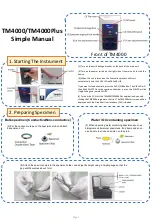
DETAILS OF EACH OPERATION
/ General Precaution for observation
II.
DSU
II .
3 - 1
Page
3 DETAILS OF EACH OPERATION
3-1 General Precaution for observation
1. Verify that input voltage/frequency to be used is within the range of that described
in identification plate of the system.
2.
Verify that power cord as well as connecting cord is securely connected.
3. In case that transmitted light phase contrast observation or transmitted light DIC
(Differential Interference Contrast) observation only is required, make one place
where fluorescent mirror unit is not attached and do observation.
4. Use field iris diaphragm, squeezing it until it circumscribes to the filed of view and,
in case that it is out of center, adjust it with use of the Allen screwdriver.
5.
Use immersion oil for objection lens of immersion type.
6. When you use objective lens of LCPlanFI series, attach a correction cap that
compensates thickness of container used for objective lens that is used for
observation. See instruction manual for IX2 series for kinds of correction caps
available.
7.
Objective lens, UPlanApo40x (cover glass thickness offset 0.11
~
0.23), PlanApo40x
(0.11
~
0.23), UApo40x3/340 (0.11
~
0.23), UPlanApo60xW3 (0.15
~
0.20),
LCPlanFI40x (0
~
2.5) and 60x (0
~
2.5), all come with a correction ring; can
compensate deterioration of resolution due to variance of cover glass thickness.
Correction method
While turning correction ring, seek the position by adjusting
focus with use of fine-tuning handle and get best possible
resolution.
8. When a pause is required frequently during observation, use shutter (manual or
electric shutter).
(If mercury lamp is turned ON-OFF so frequently, it may deteriorate life of lamp).
9.
Note to color deterioration on specimen
In case that observation is done with use of objective lens of high power, color
deterioration on specimen may occur earlier and contrast of fluorescent image may
be deteriorated. In such case, the color deterioration may defer if intensity of
excited light is lowered to a certain extent and a good fluorescent image may be
acquired. Use of ND filter is recommended to lower intensity of the excited light if it
does not bother the observation. Alternatively, use shutter so as not to apply light
source to specimen so often than it is necessary. Moreover, it can defer the color
deterioration if anti-color deterioration agent commercially available (DABCO) is
used. Particularly, it is recommended that anti-color deterioration agent is used with
high power observation.
















































